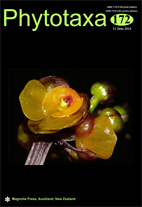Abstract
Status of numerous taxa from Silene sect. Saxifragoideae is still taxonomically unresolved, especially in the Balkans. In 1925 Bornmüller described a taxon from northern part of the Republic of Macedonia, first as S. saxifraga var. triflora and twelve years later as a separate species S. triflora. This taxon is listed in the Flora of the Republic of Macedonia as a variety of S. saxifraga. In other regional Floras regarding the Republic of Macedonia and the Balkans it is not included at any subgeneric level, or as a synonym. Delimitation between S. triflora and S. saxifraga is discussed on the basis of multivariate analysis of morphometric and meristic characters. The most significant characters for distinguishing these two taxa are stem length, inflorescence length, longest internode length, middle leaf length and the number of flowers. Considering that it was perceived that these two taxa differ significantly only in the number of flowers, addition to the original description of S. triflora is given. A specimen designated here as lectotype is deposited in JE. Considering geographic range and the number of locations, as well as the number of mature individuals in the largest population IUCN threatened status vulnerable (VU) is proposed.

